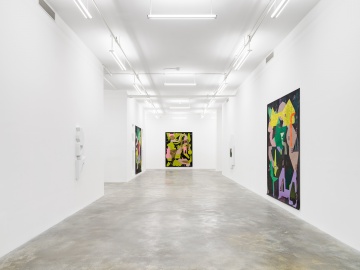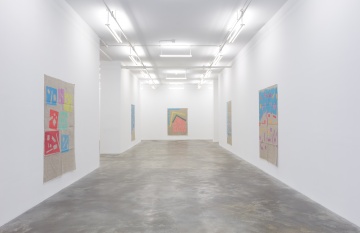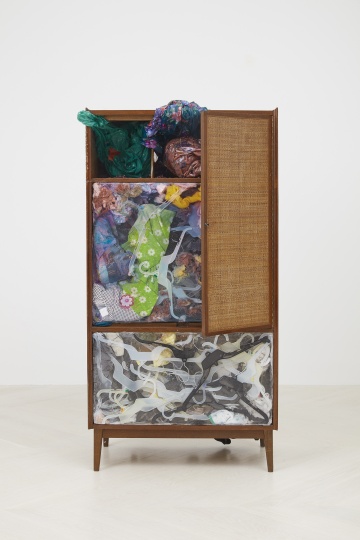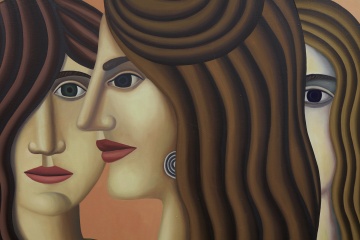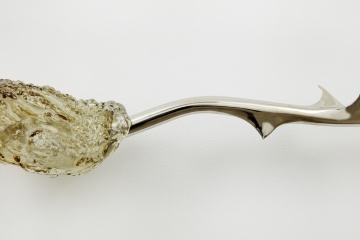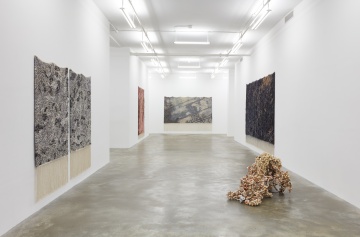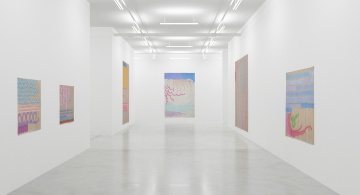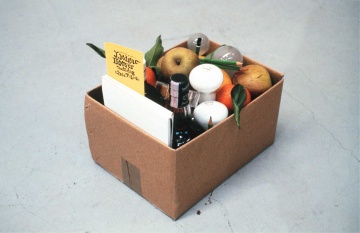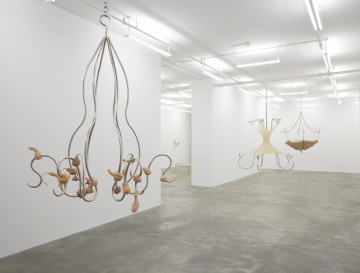Casey Kaplan
121 West 27th Street
New York, NY 10001
212 645 7335
New York, NY 10001
212 645 7335
Artists Represented:
Igshaan Adams
Kevin Beasley
Matthew Brannon
Jeff Burton
Nathan Carter
Jordan Casteel
Jason Dodge
Judith Eisler
Jonathan Gardner
Liam Gillick
Giorgio Griffa
David Huffman
Brian Jungen
Caroline Kent
Cindy Ji Hye Kim
Hannah Levy
Mateo López
Jonathan Monk
Estate of Marlo Pascual
Diego Perrone
Matthew Ronay
Simon Starling
David Thorpe
Johanna Unzueta
Ella Walker
Garth Weiser
Works Available By:
Igshaan Adams
Igshaan Adams
Kevin Beasley
Matthew Brannon
Jeff Burton
Nathan Carter
Jordan Casteel
Jason Dodge
Judith Eisler
Jonathan Gardner
Liam Gillick
Giorgio Griffa
David Huffman
Brian Jungen
Caroline Kent
Cindy Ji Hye Kim
Hannah Levy
Hannah Levy
Mateo López
Jonathan Monk
Estate of Marlo Pascual
Diego Perrone
Matthew Ronay
Simon Starling
David Thorpe
Johanna Unzueta
Ella Walker
Garth Weiser
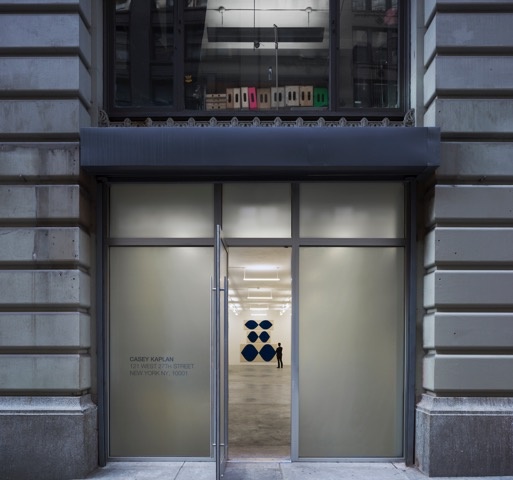
Gallery Exterior. Courtesy Casey Kaplan, New York.
Caroline Kent
This space for correspondence
November 9, 2023 - December 22, 2023
Every touching experience of architecture is multi-sensory; qualities of space, matter and scale are measured equally by the eye, ear, nose, skin, tongue, skeleton and muscle. Architecture strengthens the existential experience, one’s sense of being in the world, and this is essentially a strengthened experience of self. – Juhani Pallasmaa, The Eyes of the Skin: Architecture and the Senses, 1996
Casey Kaplan is pleased to announce Caroline Kent: This space for correspondence, an exhibition of monumental unstretched paintings with new wall-based sculptures in relief, stretched acrylic paintings, and site-specific wall cut- outs.
“This space for correspondence” is a directive often written on the back of a postcard denoting a designated area for a brief message. Postcards have become an insignia for nostalgia and the “old ways” of communication. This once- beloved labor of conveying sentimental inclinations, sublime experiences of new landscapes and architectures, and a particular type of longing is now encapsulated in a few lines penned on a 2x2-inch square, opposite images of idealized locations.
In a new body of acrylic paintings on canvas, Kent instigates sites for interpretation through emboldened black surfaces of overlapping forms, gestured through radiant and hushed tones. Her markings, in their open play, signify a type of schematic akin to asemic writing (a wordless open semantic form of writing), divulging an impression of meaning that is declarative yet inaudible. Geometric forms are recalled and recomposed from Kent’s ongoing archive of paintings on paper in which arrangements of shapes are constructed in a daily, diaristic exercise. In this way, Kent’s paintings come into being through a process that parallels how one’s personhood is actualized through constant experimentation and discernment.
An uncanny hierarchy is suggested through shadows and familiar impressions marked through sculptural relief and recess. Shapes from nearby paintings are configured into totemic formations and cut into the gallery’s walls in counter-relief, an inverse and presence of familiar and absent entities. The wall cut-outs frame two large-scale unstretched paintings, intimating columns flanking a threshold for mindful crossing.
White, stark relief structures pierce this aesthetic field with a lack of painterly gesture. Like extensions of the gallery’s walls, these forms emerge and give dimension to a memory. Several contain paintings on Belgian linen, their intimate scale compelling distilled compositions like the aforementioned square for correspondence. Imprints of memories, definitive and unreliable, are embedded in our psyches. They are idealized real fiction, not unlike a postcard’s broken dialectic of image and text, enigmatic in their want for connection. We are left in a state of eternal interpretation, turning over and over to remember what is on the other side.
Giorgio Griffa
OCÉANIE
September 7, 2023 - October 28, 2023
I gave this series the title OCÉANIE because it was born from a reflection on the work of Matisse – Océanie, La Mer (1946), and Océanie, Le Ciel (1946).
Once Newton's perfect mechanical universe has fallen apart, Matisse represents space by occupying it rhythmically, a sign after another, like walking, one step after another.
In our quantum universe, life is everywhere. Everything is born and everything dies.
From the infinite smallness of particles (one billionth of a millimeter) to the infinite largeness of the universe (billions of light years), the indeterminate energy builds identities, worlds, flowers, people, trees, stones, water, air, fire, stars, and galaxies.
Every identity lives and dies, and when it dies it returns to the primary energy, immense and unknown.
Each sign of the brush is a new identity on its own, there is no need for it to represent anything other than itself. It is both reality and representation of reality.
Material reality are the marks left directly by the brush. Immaterial reality, such as thought, are the marks that emerge from the painting outside of them.
Giorgio Griffa, 2023
*
OCÉANIE consists of a series of nineteen paintings created between the fall of 2022 and the spring of 2023, marking the most significant shift in Giorgio Griffa’s practice in over a decade. This is the artist’s sixth solo presentation at the gallery.
Since 1968, Griffa has developed a painting practice that records “the memory of material,” allowing brush, paint, and canvas to dictate the outcome of his work. By eliminating perspective and narrative, Griffa’s “fragments of space” simply record the repetitive and spontaneous sequences of marks and gestures. Beginning with unprimed, unstretched raw canvas laid out like sheets on the floor, Griffa works slowly across them, crouching and kneeling on the material in a way that aligns him with his tools: water-based acrylic paints, mixed thinly, that seep and bleed upon application. The rawness of the resulting color fields, along with the large areas of unpainted canvas, gives Griffa’s paintings a provisional feel, emphasizing his convictions about the independent life of the materials. The paintings are exhibited unframed, pinned directly to the wall with small nails along their top edge, and when not displayed, are folded into sections and stacked, creating an embossed underlying grid for his compositions. In conjunction with the opening of OCÉANIE, MASSIMODECARLO London will be hosting a solo presentation featuring Giorgio Griffa's 1990s cycle entitled Tre Linee e un Arabesco, running from September 7 - October 7.
Giorgio Griffa (b. 1936, Turin) lives and works in Turin, Italy. Recent exhibitions include Centre Pompidou, Paris, France (2022) (solo); Musée des Beaux-arts de Chambéry, Chambéry, France (2022) (solo); Lille Métropole Musée d’art Moderne, Villeneuve-d’Ascq, France (2021) (solo); São Paulo Art Biennial, São Paulo, Brazil (2021); Palazzo Collicola, Spoleto, Italy (2021) (solo); Camden Arts Centre, London, UK (2020); Centre d’Art Contemporain Genève, Switzerland (2020); Tate Modern, London, UK (2019); Musée des Beaux-Arts de Nancy, Nancy, France (2019); Camden Arts Centre, London, UK (2018) (solo); Viva Arte Viva, 57th International Art Exhibition, Arsenale, Venice, Italy (2017); Castello di Rivoli, Turin, Italy (2017); Fundação de Serralves, Porto, Portugal (2016) (solo, traveling); Fondazione Giuliani, Rome, Italy (2016) (solo, traveling); Bergen Kunsthall, Bergen, Norway (2015) (solo, traveling); and Centre d’Art Contemporain Genève, Genève, Switzerland (2015) (solo, traveling); Fondazione Carriero, Milan, Italy (2015); Fondazione Palazzo Albizzini Collezione Burri, Perugia, Italy (2015); a group show curated by Ugo Rondinone at Secession, Vienna, Austria (2015); Serralves Museum, Porto, Portugal (2014); Mies van der Rohe Haus, Berlin, Germany (2013) (solo); MACRO, Museu d’Arte Contemporanea, Rome, Italy (2011) (solo); Museo d’arte contemporanea, Lissone, Italy (2010); and Peggy Guggenheim Collection, Venice, Italy (2009). Griffa’s work can be found in permanent collections including Tate Modern, London, UK; Castello di Rivoli Museum of Contemporary Art, Rivoli, Italy; Dallas Museum of Art, Dallas, Texas, US; The Museum of Fine Arts, Houston, Texas, US; Frac des Pays De La Loire, Carquefou, France; Fundação de Serralves, Porto, Portugal; Galleria d’Arte Moderna, Rome, Italy; Galleria di Arte Modernea e Contemporanea, Turin, Italy; Grand Duke Jean Museum of Modern Art, Luxembourg; and Museo del Novecento, Milan, Italy.
Simon Starling
Simon Starling: Title TBC
January 19, 2023 - March 4, 2023
Jeff Burton
Jeff Burton: Title TBC
January 19, 2023 - March 4, 2023
Liam Gillick
Liam Gillick: Redaction
March 3, 2020 - April 25, 2020
Liam Gillick
Redaction
March 3 - April 25, 2020
However hard you try it’s always tomorrow. And now it’s here again.[1]
Casey Kaplan is pleased to announce Liam Gillick: Redaction, the artist’s ninth solo exhibition with the gallery over a two-decade collaboration. The show brings together a selection of key texts, abstract structures and installations, spanning the early 90s to the late 2000s, and will coincide with the gallery’s 25th anniversary.
Since the late 1980s, Gillick has employed a variety of methodologies to explore the semiotics of the built world. Writing has maintained a crucial role in his practice, culminating in an eclectic collection of fictional texts that resist linear narrative in favor of fragmented dialogue, stream of consciousness, and abrupt slips in time. In addition to these narrative devices, Gillick often uses historical revisioning as an exercise through which to imagine alternative parallel futures. Continually referenced, decontextualized, and reworked, the texts remain in a permanent state of development and transformation in order to examine shifting modes of production and the psychosocial implications of late capitalism.
A selection of Gillick’s earliest writings provide a conceptual framework for this exhibition, including: McNamara (1992-1995), Erasmus is Late (1995), Ibuka! (1995), and Discussion Island/Big Conference Centre (1997). Many of the artworks were produced in relation to specific ideas contained within the texts, encompassing ergonomics, conditions of production, the influence of secondary characters, the aesthetics of both secondary and tertiary sectors, and the disillusionment of utopian projections of the future. Formal abstractions and instructional installations exist as potential props or mis-en-scenes, in loose correlation to the narratives. Rejecting a cause-and-effect logic, the works instead propose a variety of potential scenarios to reflect the nuanced contexts in which abstract ideas are realized.
A series of Plexiglas and powder-coated aluminum structures resume the language of renovation and development utilized in the texts. The materials are specifically chosen for these connotations and often embody the formal qualities of secondary architecture. Canopies suspended from the ceiling incite the unconscious congregation of bodies; a free-standing screen provides access visually while blocking physical entry, and ill-placed handrails create arbitrary divisions, but deny stability. Within this non-functional “middle space,” the artworks maintain an elusive and open-ended quality, persistently asking “What If?” while refuting a definitive answer. Acutely self-aware, but without irony or cynicism, the work parodies the perpetual speculation of corporate culture and the desire to preserve an illusion of progress. In face of the increasingly rapid rate at which models of collectivity and resistance are outmaneuvered, co-opted and rebranded within neoliberal societies, Gillick’s work has continued to encourage discourse and collective exchange over three decades of artistic production.
Liam Gillick lives in New York. His work has been the subject of numerous solo exhibitions internationally, at institutions such as: Madre Museum, Naples; Kunsthalle Wien, Vienna; Contemporary Art Centre, Vilnius; Serralves Museum of Contemporary Art, Porto; Le Magasin, Grenoble; Hessel Museum of Art, Bard College, New York; Museum of Contemporary Art, Chicago; the Guggenheim Museum, New York and Bilbao; Museum of Modern Art, New York; and Tate, London, among many others. Gillick has participated in documenta, and the Venice, Berlin and Istanbul Biennales - representing Germany in 2009 in Venice. A prolific writer and critic of contemporary art over the last twenty-five years, Gillick has contributed to publications such as Artforum, October, Frieze and e-flux Journal. He is the author of a number of books, including a volume of his selected critical writing and the recently-published Industry and Intelligence: Contemporary Art Since 1820 (Columbia University Press, March 2016). Additionally, Gillick has produced a number of short films since the late 2000s, which address the construction of the creative persona in light of the enduring mutability of the contemporary artist as a cultural figure. High-profile public works include the British Government Home Office (Interior Ministry) building in London and the Lufthansa Headquarters in Frankfurt. His work can be found in institutional collections such as Centre Pompidou, Paris; Solomon R. Guggenheim Museum, New York and Bilbao; Museum of Modern Art, New York; Tate, London; and Serralves Museum of Contemporary Art, Porto.
___________________________________________________
[1] Liam Gillick, Big Conference Centre, 1997
Hannah Levy
Hannah Levy: Pendulous Picnic
January 23, 2020 - February 29, 2020
Casey Kaplan is pleased to announce Hannah Levy “Pendulous Picnic,” the artist’s first solo exhibition with the gallery.
Levy’s sculpture both incite and repel touch. By manipulating texturally incongruous materials such as silicone and steel, Levy produces tactile structures that arouse an acute bodily awareness. Her references are broad: medical equipment, hardware, prosthetics, vegetables, and furniture are anthropomorphized through welded curves and cast appendages that relate to the human form. The scale of recognizable, everyday objects is often distorted to the point of absurdity, resulting in uncanny configurations that have lost their original function. Expanding upon the visual language of artists such as Eva Hesse, Louise Bourgeois and Meret Oppenheim, Levy’s sculptures are defined by their materiality and bodily consciousness.
For this exhibition, Levy presents a series of new works formally inspired by domestic décor and objects of recreation. Through these referents, her sculptures engage the aspirations and insecurities embedded within our designed environments. All of the works contain competing dualities - erotic and sterile, seductive and repulsive, humorous and disconcerting - to subvert the concept of “tastemaking” perpetuated by interior and industrial design.
In the main entryway gallery, three large-scale works hang from the ceiling on thick, metal chains. The elaborate sculptures recall distorted chandeliers – once symbols of wealth and nobility, that have since devolved into cheaply-produced and often gaudy commodities. In Levy’s adaptation, the metal sculptures are shaped by exaggerated, sensual curves and adorned with flesh-like silicone, reflecting a perverse eroticism often hidden in modern design. Oversized and presented low to the ground, the
sculptures confront the viewer with their own physicality and elicit a corporeal discomfort through both tactile and formal means. One work is furnished with a series of alarmingly sharp hooks, indulgently pierced with over a dozen silicone cast gourds. Another holds a large, silicone pool inflatable with distinguished air valves that take on suggestive connotations at this exaggerated scale. While amusing, the works’ humor is bellied by a latent anxiety that permeates throughout the exhibition.
In contrast to the extravagance of the chandeliers, a series of modestly-scaled fixtures, recalling light sconces, line the walls of the gallery. Each metal armature is welded into a curved point and holds a cast asparagus in lieu of a candle or lamp. The plump, tactile silicone is pigmented in anemic shades of beige, accentuating a homogeneous, flesh-like quality. Enlarged several times over, the asparagus rests languidly over the nickel plated steel - limp and phallic. On the floor lays a large, free-standing sculpture, embellished with menacing metal springs and taught, stretched silicone. The structure appears familiar, but the scale remains awkwardly undetermined – smaller than an outdoor trampoline, but larger than indoor rehabilitation equipment.
Levy transitions into a two-dimensional plane within the remaining gallery space, engaging recurrent themes through different means. In this room, a photograph portrays a manicured set of hands baiting a fishhook with a live worm. Recreational fishing is a pastime with both blue-collar and aristocratic affiliation. In contrast with this subject matter, the sleek, commercial aesthetic of the photograph suggests the very notion of gratuitous leisure might be illusory. The haptic focus of the image intensifies the tactility which binds all of the works in the exhibition and acknowledges the persistent desire to touch in an increasingly virtual world.
All of the works in the show conflate flesh and steel, encapsulating the bodily integration of the once external machine. With a keen material sensibility, Levy’s sculptures reflect the internalization of our built and bought environments. Each component exists with the potential to be consumed, in a perverse metabolic cycle that questions the very nature of consumption - both biologic and cultural.
Levy (b. 1991, New York) received her MFA from Städelschule, Frankfurtin 2015. She has held recent solo exhibitions at Fondazione Coppola, Vicenza, Italy (2020); C L E A R I N G, New York (2018), Mother’s Tankstation, Dublin (2018); Fourteen30 Contemporary, Portland (2017); White Flag Projects, St. Louis (2016) and Galerie Parisa Kind, Frankfurt (2015). Additionally, her work has been exhibited at museums internationally, including: G2 Kunsthalle, Leipzig, Germany; Yuz Museum, Shanghai; Louisiana Museum of Modern Art, Denmark; Museum of Modern Art, Humlebæk; MoMA PS1, New York; the Frankfurter Kunstverein, Frankfurt; SCAD Museum of Art, Savannah; Palais de Tokyo, Paris; Lever House, New York and Museum Für Moderne Kunst, Frankfurt. In May of this year, Levy will unveil a major new public work, commissioned by High Line Art and Friends of the High Line, New York and on view through March 2021.
N. Dash
September 5, 2019 - October 26, 2019
Matthew Ronay
Betrayals of and by the Body
April 30, 2019 - June 15, 2019
Mateo López
Play
January 11, 2019 - February 16, 2019
Geoffrey Farmer
Mudpuddlers, Corn Borers, Polymorphic Platyforms
November 1, 2018 - December 22, 2018
Judith Eisler
Riffs. Jarman’s Caravaggio
September 6, 2018 - October 20, 2018
Jason Dodge
hand in hand with the handless
June 21, 2018 - July 27, 2018
Matthew Brannon
May 1, 2018 - June 16, 2018
Sarah Crowner
February 26, 2018 - April 21, 2018
Giorgio Griffa
The 1980s
January 11, 2018 - February 17, 2018

 Back to all Member Galleries
Back to all Member Galleries
